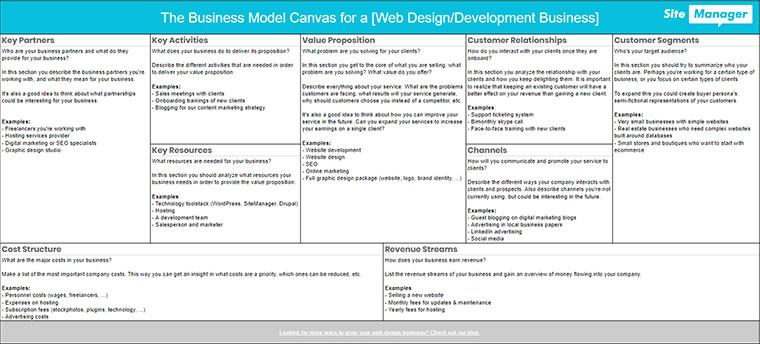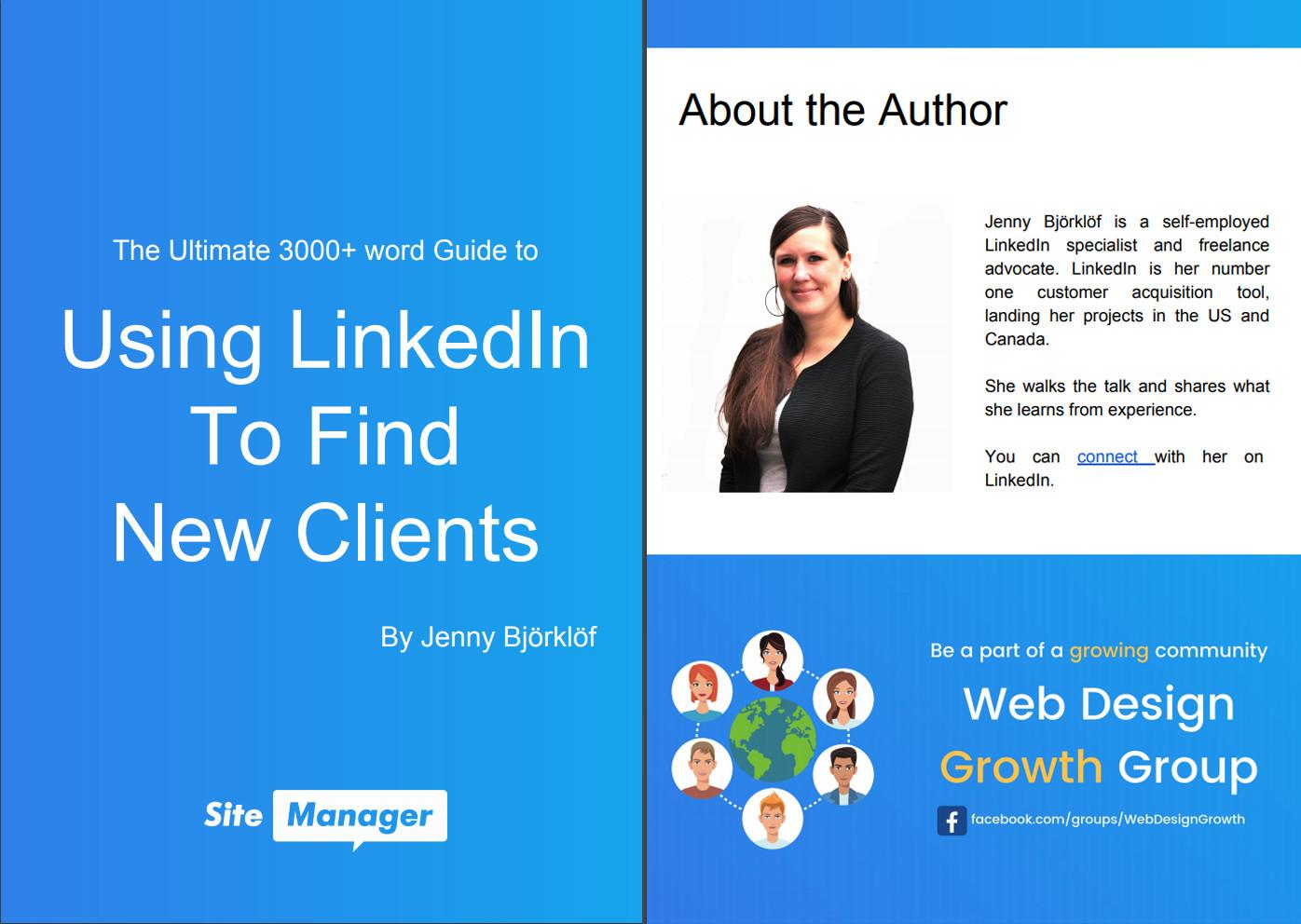The Superstar Growth Guide for Web Design Businesses

Ready to learn what it takes to grow your web design business? From snappy startups to experienced entrepreneurs, anyone can benefit from the helpful advice in this guide.
Chapters
Chapter 1: Learn the Lay of the Land and Make a Business Plan

The Business Model Canvas
Pricing models
1. Project-based business model
2. Hourly billing business model
3. Subscription-based business model
Mix it all up
Of course, none of this is written in stone. The model you choose will often depend on the project. Most companies use a combination of these different models:
Very often, businesses will specialize in a certain kind of website. Then there are web design companies churning out a huge volume of small websites each month. Other companies only work on very complex projects. It really depends on what you like.
Chapter 2: Marketing your Web Design Company
A website has two primary goals:

You can attract via ads, SEO, posting on social, etc. To convert, your website needs to provide content for people in every phase of the buyer’s journey.
Building a Standout Portfolio
When potential clients are searching for a web designer or developer, they have different goals and ideas in mind. But the one constant you can count on is the fact that they want to see proof of your work.
There is a lot you can do to build an irresisible portfolio, but make sure you take care of these:
Get Testimonials
Testimonials are a form of social proof: you borrow third-party influence to sway potential customers. These days, any website that advertises a service must have them. Otherwise, the site looks, well… naked.
Networking
You can go the old fashioned way and attend events at your local chamber of commerce, seminars, web design community events, etc. Or you can start networking online, via social media platforms that were designed for it... like LinkedIn.
Get Exposure
This speaks for itself: you won’t get clients if nobody knows your company exists. So you need to get out there and build a reputation. There are several ways to achieve this:
Guest Blogging
Have you considered writing some guest blog posts for a well-known blog? Blogs are always looking for people to create new content. Writing blogs under your own name can help you build a reputation. Ideally, these blogs could create backlinks to your own website.
Social Media
Your personal network is your strongest sales team. You’d be surprised to know how many web professionals find new clients because someone referred them. But you need to make sure that the people in your network know that you have a web business. Being active on social media will achieve this.
Don’t underestimate the importance of your Facebook and LinkedIn pages. These are just as important as your website.
SEO
Optimizing for search engines is obviously a good way to generate traffic to your website. But this isn’t always easy in the web design business because it’s a highly competitive market. SEO is something that takes a lot of time before it starts paying off.
Local SEO
Local SEO is potentially more interesting because there are simply fewer companies trying to rank for, let’s say, “Web design agency in Copenhagen” than for “Web design agency”. Also, many customers are still more interested in working together with a person they can meet face-to-face, than through email and video calls.
Chapter 3: Generating Leads

Inbound
Inbound is a relatively new and popular approach to marketing. Contrary to what people in your field might say, it’s much more than a buzzword. It’s a shift in marketing culture. In case you missed the Inbound trend of the last few years, here it is defined in one quick-and-dirty sentence: Inbound marketers try to build relationships with potential customers by offering them content. It’s non-intrusive and indirect.
Setting up funnels
A lot of web development businesses make the same common mistake. Their only call-to-action (CTA) is a colored button that says “get a quote”.
This is not a good CTA.
Why not? It will only be relevant to very hot leads, meaning people or businesses who are seriously considering hiring you to build their website. But people who aren’t there yet won’t click that CTA. You’re going to need a lot more of them, covering a much more diverse set of actions.
If you run a business, no doubt that you’ve had that feeling too: you want to know what something costs, but you don’t want to ask a quote with the risk of getting in too deep.
At that point, your website will have failed its purpose: converting visitors into leads. A sales funnel is the process of converting prospects to customers. There are three phases in any funnel:
Once you’ve got yourself a list, you can find out what leads would be a good fit and send them emails or call them.
Outbound
Telemarketing
Making a list of companies that you think might be interested and picking up the phone is called “cold calling”. You’ve got no idea whether the companies are really interested in your product, so your lead is still cold. While you’ll definitely be able to generate some clients this way, it can be exhausting because conversions are pretty low. For example, at SiteManager we use some cold calling to generate leads, and for every 100 calls, we get about 5 signups for a demo. Those really aren’t stat to get excited about. Alternatively, you could find a company or freelancer that does the telemarketing for you.
Email marketing
Email marketing is very similar to telemarketing, but you’ll send emails instead of picking up the phone. You can reach a lot more businesses this way, but conversion rates are lower. Ideally, you could combine email marketing with inbound tactics to grow your list of subscribers in a legal and non-intrusive way.
Advertising
Whether it’s online with Google Adwords or Facebook Ads or offline in your local chamber of commerce magazine, ads are a good way to get some leads for your business.
There are tons of salespeople who don’t even leave their laptops anymore. Via LinkedIn you can easily start connecting with people, send them messages, and share articles and content with them.
Referrals
A great way to generate leads for your business is getting referrals, as word-to-mouth is extremely important. If you deliver excellent quality websites, chances are your clients will recommend you to their friends, family and colleagues.
One thing that a lot of web design businesses do is starting a referral program. Essentially, you'd be giving a reward to anyone who delivers you a new client. This can go as far as you want, from a small gift to €200.
The best thing about referrals is that you usually get a lot of hot leads from it. Leads that are actively looking for a company that builds websites. So it should be fairly easy to convince them you're the one, especially when you've got someone vouching for you.
Stop looking for leads. Build recurring partnerships
Another way to get clients is by building recurring partnerships with marketing agencies, PR firms, etc.
Once you get hired by one of these agencies, offer them the very best service you can and make sure they keep coming back for more.
Many freelancers can keep their business running with just one or two of these major firms hiring them. But be aware of becoming too dependent on just a few sources of income.
Chapter 4: Offer more and earn more on a single client.
As a web designer, your main focus is on creating awesome websites and finding new customers.
And we all know that finding new customers is not that easy in this business. In fact, it can be downright painful, especially in a global web design market where you’re competing with people overseas.
It could be more interesting to try and earn more from existing clients by expanding your services. Because the prices for a basic website is under enormous pressure, this is where you can really grow your revenue.

Offer a full-service
A lot of companies appreciate having a single point of contact for all their online affairs. That’s why a lot of web design agencies have gone ‘full-service’. This means they don’t just design websites but also provide hosting and maintenance.
For many clients, this is important, because they don’t see design, maintenance and hosting as separate products in the first place. A lot of business owners just want to see a website online, and want a single point of contact to fix it for them.
Keep in mind that you don’t need to do everything yourself, even if you’re working alone. Set up partnerships or hire freelancers to expand your services without growing the fixed costs of your business.
Exemplary customer service
By offering a great service, you won’t just delight your existing customers, making them come back for more. You’ll also start getting recommended.
Word-of-mouth is extremely important in the web design business. Whether your clients make a recommendation to colleagues, competitors or friends will greatly depend on how well you do with your customer service.
A good way to improve your customer service starts before you build the website. Take your time to really understand clients AND their clients. By really understanding the challenges your client has, the problems they want to solve, and the target audience, you’ll be able to deliver a better product.
Cross-selling
Cross-selling and upselling are techniques to convince clients to buy extra services. We’ve all seen this in action before. Think about the time you ordered a hamburger and the cashier asked, “Do you want fries with that?”.
In the website business, SEO is your fries. You could try to offer SEO services or e-commerce solutions on top of your website. There are lots of other things you can do:
A good way to sell these extra services is by attaching estimates for relevant services to your quotes. Don’t be too aggressive though. You don’t want to spook the client!
Always keep in mind that it is essential that you maintain a positive relationship with your client. Don’t try to sell them services that they don’t need, but focus on what they really need.
Invest in maintaining relationships
Websites are never set in stone and will need to be refreshed every couple of years. If you’re looking for revenue, it’s always a good idea to pick up the phone and start calling your existing customers.
It’s important to realize that your existing customers are your best customers. According to research the probability of selling to an existing customer is 60-70%, while the probability of selling to a new prospect is only 5-20%.
This is because there are much less obstacles when selling to an existing customer. You already have a relationship and (hopefully) their trust.
Keeping in touch with your existing customers can be a very rewarding strategy to increase your revenue. There are multiple ways to do it.
You could take a more personal approach and actually periodically call your clients. Many companies schedule a call every couple of months and just have a chat with their client. Is their website performing as expected? Would they like any changes?
While a personal approach is great, it’s also time-consuming.
Another approach is using automated mailing sequences. Create newsletters for your existing customers, informing them about new services you provide, new projects you’re proud of, etc. Or send them simple periodic mails: “Hi, I just wanted to hear how you’re doing. Is business going good?”
Just keep communicating!
Chapter 5: Specialization
The future of the web design industry does not lie in a race-to-the-bottom, with designers trying to sell their websites at the lowest possible cost. The future is in selling expertise and knowledge of how you are going to make a website successful.
Specializing can help you position yourself as an expert in a certain field.

Word-to-mouth
If you start building websites for a specific type of industry, you’ll quickly make a name for yourself. Next thing you know, people will start contacting you because you’ve built a website for their colleagues.
Specialization will help you gain more leads because of referrals within a certain industry or sector. It’s a small world.
Expertise
Because of your experience with a certain industry, you’ll often have some valuable insights into what problems a business is facing and how a website could help them with those problems.
When you’re trying to sell to a customer, they’re not interested in your product. They are interested in which of their problems your product will solve. By knowing the business better, you’ll be able to really focus on their problems and how a website can solve them.
And the best thing is: it can potentially increase the value of your websites because you’re bringing your experience to the project, thus increasing its price.
Choosing a specialization
There are many specializations you could pursue. You can either specialize in a certain industry or in a certain type of website.
Industry:
Types of websites:
Which specialization you choose can depend on many things. Do you have a strong network somewhere? Perhaps you know some people in a certain industry? This can give really help you get started.
If you don’t, you can also just pick a specialization based on what interests you, or perhaps you’ve experienced that there isn’t a lot of competition for a certain niche. It possible to choose your own niche and specialize in it.
Be a generalist
Obviously it’s also perfectly possible not to be a specialist. There are a lot of web designers and developers out there that are generalists: they’ll work on different types of websites for different types of businesses.
Especially when you’ve just started your business, it’s recommended that you take on a generalized approach. You’ll get a wider range of people contacting you to build their websites, giving you the opportunity of finding out which types of websites or which clientele you like.
Chapter 6: Flying solo with freelancers or hiring employees
Working by yourself is a comfortable choice that involves little risk. But obviously, it limits the potential growth of your company. No matter how hard you work, you’ve still got to sleep.
Working alone can also be tricky because when you are working on a project, you’re not scouting new projects. This means that once your project is finished, you won’t necessarily have a new project waiting for you.
So exclusively working on your design or development could hurt your business. You’ll have to do some marketing and sales to grow.
Luckily we’re living in a time where you don’t necessarily need to get someone on your payroll to deal with the extra work.

Hiring a freelancer
When your business grows, you’ll need some extra hands on deck. But getting someone on the payroll isn’t always the easiest choice.
As the digital nomads of today’s workforce, freelancers work (remotely) on a project-by-project basis, helping companies accomplish tasks that would be too expensive or impossible for their in-house team.
Freelancers can add value to your business by helping you avoid taking on unnecessary new hires or other expenses:
Using the expertise of a freelancer sounds great, and truthfully, it is… unless you go about it the wrong way. Read our in-depth guide on collaborating with freelancers for more insights.
The biggest risk is becoming overly dependant on one freelancer. Freelancers love their freedom and are often opportunity-driven. It happens that a better opportunity comes by and they won’t have any time left for your projects.
Something you must absolutely avoid is being left in the cold when he/she stops the collaboration.
Hiring an employee
Once you’ve got enough work on your plate for a longer period, you can start hiring employees. At this point, taking someone on becomes a more viable option because there’s a sweet spot at which it becomes more profitable to get someone on the payroll than hiring a freelancer who works for an hourly rate.
Organizing the work
All too often, clients of web businesses complain about designers/developers not responding to calls or emails, not finishing the jobs, or delivering websites that don’t work as promised.
This isn’t always intentional.
Especially with small growing businesses, processes aren’t established and this can cause chaos. That’s when you need to get serious about organization. That’s the moment to start using project management tools.
Project management tools will help you get an overview of everything that is happening in your business, and the things that are in the pipeline.
There are many such tools out there such as Asana, Favro, Trello. At SiteManager, our web developers use Favro to keep track of the work.
What’s Next?
While we’ve covered all the essentials you’ll need to know about for growing your web design business, we’re really only scratched the surface of what it takes to be truly successful and grow, year after year.
Remember to always be on the lookout for new tools, new skills, and new techniques you need to know about in order to stay viable in this tougher-than-nails environment.
If you’d like to see what other tips and advice we have for you, please feel free to visit our company blog often. It’s where we put our latest and greatest ideas, thoughts, and stories, so hop on over any time.




